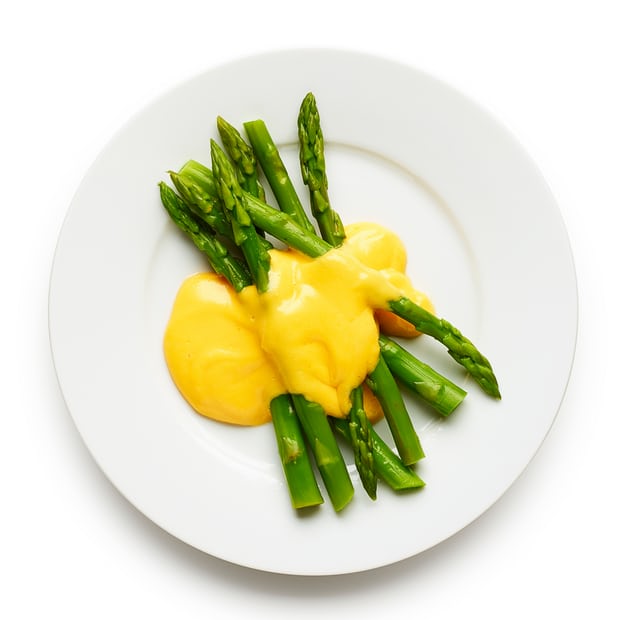Felicity Cloake's masterclass: a hollandaise recipe
This rich, velvety sauce can be temperamental, so follow these simple steps to get it just right

Smooth and creamy: hollandaise is perfect with this season's asparagus. Photograph: Dan Matthews for the Guardian
For the next six weeks, consider it your patriotic duty to consume as much asparagus as possible – it's not a vegetable that travels well, so once the British season ends on midsummer's day, that's it for another year. Delicate, early stalks are best steamed and served with buttery hollandaise: here's a foolproof recipe you can have on the table in 10 minutes.
- Prep 5 min
- Cook 10 min
- Makes 300ml
- 250g cold unsalted butter
- 4 egg yolks
1 Prepare the butter
Cut the butter into roughly 1cm cubes. The butter should be fridge-cold, and preferably unsalted, so it's easier to control the seasoning of the sauce. Put it in a small, heavy-based saucepan and, as insurance against disaster, fill the sink with cold water and boil a small amount in the kettle (see steps 4 and 7).

It's essential that the butter is fridge-cold before you start, so you have more control over the sauce. Photograph: Dan Matthews for the Guardian
2 Prepare the eggs
Separate the eggs, and reserve the whites for something else –meringues, mousses, whisky sours or depressingly low-fat omelettes. They'll keep, covered, in the fridge for a couple of days, or freeze in ice cube trays or bags (make sure you label the latter, so you know how many are in there). Put the yolks in the pan with the butter and add two tablespoons of cold water.3 Start the sauce

Very slowly heat the butter and egg yolks, stirring all the time, until the butter melts and the sauce emulsifies.
Turn the heat on very low under the cold pan and start stirring – it's easiest to start with a wooden spoon. As the butter gradually melts, the sauce will begin to thicken: do not be tempted to hurry the process by turning the heat up, or the mixture is likely to curdle. The sides of the pan should be cool enough to touch at all times.4 Start whisking
Keep stirring vigorously; then, as the butter melts, switch to whisking – it's important that you now don't stop whisking until the sauce is ready, so if the doorbell rings, plunge the pan into the cold water in the sink (see step 1) to halt the cooking process, otherwise you risk the egg scrambling before it has a chance to form an emulsion with the butter.5 Keep going until it's thickened
Once all the butter has melted, turn up the heat very slightly and whisk vigorously until the sauce has thickened sufficiently for your purposes (see step 8). If the sauce begins to steam at any point, plunge the pan into the cold water in the sink at once, and keep whisking until it calms down.

Once the butter and eggs have emulsified, swap the spoon for a whisk and beat until the sauce thickens.
6 Season, then eat
Add a tablespoon of lemon juice, then season the sauce to taste. Keep warm until ready to serve: hollandaise will not reheat successfully, so it's best eaten at once, but if you do have to make it in advance, it's best stored in a Thermos flask or in a heatproof bowl set over, but not touching, a pan of simmering water.
7 And if it curdles …
You may be able to rescue a curdled sauce by whisking in a little boiling water (hence the kettle in step 1), but if that fails to fix the problem, pour the split sauce into a heatproof jug, clean the pan and whisk another egg yolk with a splash of water in there. Gradually whisk in the curdled hollandaise until it's all incorporated, then carry on where you left off.
8 Thick or thin?
I like my hollandaise fairly liquid when serving it with asparagus, because it can be poured over the steamed spears, but if you're using it as a dip or making eggs benedict, you may prefer a more mayonnaise-like consistency. If it thickens too much, whisk in a little hot water from the kettle (see step 1) to thin it down.
9 A variation
For béarnaise, simmer four tablespoons of white-wine vinegar with four tablespoons of water, a finely chopped shallot and three tarragon stalks stripped of their leaves, until reduced by half. Cool, strain, then add to the hollandaise at step 2, and stir in the chopped tarragon leaves at the end.